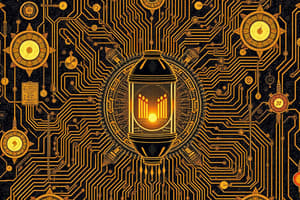Podcast
Questions and Answers
Which of the following best describes a collector in a PNP transistor?
Which of the following best describes a collector in a PNP transistor?
- It is where current enters the transistor. (correct)
- It allows current to flow towards the base.
- It is connected to the lower voltage side of the circuit.
- It is responsible for switching the current on and off.
What distinguishes a 1kΩ resistor from a 10kΩ resistor based on its color code?
What distinguishes a 1kΩ resistor from a 10kΩ resistor based on its color code?
- The 1kΩ resistor has a third band of orange.
- The 10kΩ resistor has a first band of red.
- The resistor value is indicated by the second band.
- The 1kΩ resistor has a third band of red and the 10kΩ has orange. (correct)
What is the main function of transistors in electronic circuits?
What is the main function of transistors in electronic circuits?
- To regulate voltage levels.
- To limit the flow of current like a resistor.
- To amplify and switch electrical signals. (correct)
- To store electrical charge.
Where is the emitter terminal typically connected in an NPN transistor?
Where is the emitter terminal typically connected in an NPN transistor?
Which statement about resistors is correct?
Which statement about resistors is correct?
What does a combinational circuit's output depend on?
What does a combinational circuit's output depend on?
What is the primary function of a Half-adder circuit?
What is the primary function of a Half-adder circuit?
Which flip-flop has an indeterminate state that is typically avoided?
Which flip-flop has an indeterminate state that is typically avoided?
What is the role of a D Flip-Flop in digital circuits?
What is the role of a D Flip-Flop in digital circuits?
What happens when both inputs of a JK Flip-Flop are set to 1?
What happens when both inputs of a JK Flip-Flop are set to 1?
How many outputs can a decoder with 'n' inputs produce?
How many outputs can a decoder with 'n' inputs produce?
What is the primary function of an encoder in digital circuits?
What is the primary function of an encoder in digital circuits?
What characterizes a Multiplexer (MUX)?
What characterizes a Multiplexer (MUX)?
What happens to the T Flip-Flop output when the input T is set to 0?
What happens to the T Flip-Flop output when the input T is set to 0?
In the context of flip-flops, what does a clock signal do?
In the context of flip-flops, what does a clock signal do?
Study Notes
Transistors Overview
- Transistors serve the dual purpose of amplifying and switching electrical signals in electronic circuits.
- Common types include NPN and PNP transistors, each distinguished by their current flow direction.
Transistor Terminals
-
Emitter (E):
- In NPN transistors, current leaves through this terminal.
- In PNP transistors, current enters through this terminal.
- Typically connected to the lower voltage side of the circuit, such as ground in NPN configurations.
-
Base (B):
- Acts as the control terminal for the transistor.
- A small current or voltage applied here governs a larger current flow between the emitter and collector.
-
Collector (C):
- In NPN transistors, main current flows into this terminal.
- In PNP transistors, main current flows out of this terminal.
- Usually connected to the higher voltage side of the circuit.
Current Flow Mechanism
-
In NPN transistors:
- A small positive voltage at the base permits a larger current to transition from the collector to the emitter.
-
In PNP transistors:
- A small negative voltage at the base allows current to flow from the emitter to the collector.
Applications
- The ability to amplify or switch electrical signals makes transistors crucial in various electronic applications.
Resistors Characteristics
- A resistor limits or regulates the flow of electrical current within a circuit.
- Color coding is essential for identifying resistor values:
- For a 1kΩ resistor, the third color band (multiplier) is red.
- For a 10kΩ resistor, the third color band is orange.
Combinational Circuits
- Combinational circuits are formed by logic gates; outputs depend only on the present input combination.
- Perform specific operations, defined by Boolean functions.
Half-Adder Circuit
- Requires two binary inputs and produces two binary outputs: sum and carry.
- Inputs represent the augmented and added bits.
Full Adder
- Adds three single-bit binary numbers: two input bits and a carry-in bit.
- Produces two outputs: sum and carry-out.
Flip-Flops
- Flip-flops are circuits that maintain a binary state until changed by an input signal.
- Types of Flip-Flops include:
SR Flip-Flop
- Basic flip-flop with two inputs: Set (S) and Reset (R).
- S = 1 & R = 0 sets output Q to 1.
- S = 0 & R = 1 resets Q to 0.
- S = 1 & R = 1 leads to an indeterminate state (output unpredictable).
D Flip-Flop
- Offers a single input (D) and a clock signal.
- Captures data from D on the clock's rising edge, storing it in output Q.
- Commonly used in registers and memory for data storage.
JK Flip-Flop
- Versatile flip-flop with inputs J and K.
- J = 1 & K = 0 sets Q to 1; J = 0 & K = 1 resets Q to 0.
- J = 1 & K = 1 toggles the output.
- Resolves indeterminate state issues found in SR flip-flops.
T Flip-Flop
- Contains a single input (T) and a clock signal.
- When T = 1, output toggles with each clock pulse; T = 0 keeps output unchanged.
Decoder
- A combinational circuit that converts binary input of 'n' bits into up to 2^n distinct outputs.
Encoder
- Performs the inverse operation of a decoder; has maximum 2^n inputs and n outputs.
Multiplexer (MUX)
- A combinational circuit that selects one of 2^n input data lines to direct to a single output line.
- Selection based on control lines, often referred to as a data selector.
Register
- Fast memory utilized for accepting, storing, and transferring immediate data and instructions for the CPU.
- Comprises a group of flip-flops, with each capable of storing one bit of information.
Shift Registers
- Specialized registers that can shift binary data in one or both directions.
- Constructed as a series of flip-flops where the output of one is linked to the input of the next.
Studying That Suits You
Use AI to generate personalized quizzes and flashcards to suit your learning preferences.
Description
Test your knowledge on the basic functions and terminology of transistors. This quiz covers key concepts such as the emitter, base, and collector terminals along with their roles in amplifying and switching electrical signals. Perfect for students studying electronics and circuit theory.




